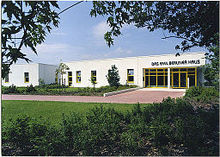Emil Berliner Studios
The Emil Berliner Studios , named after the inventor of the gramophone and the record , are a recording studio in Berlin . The studios emerged from the recording department of the Deutsche Grammophon Gesellschaft .
history
The Deutsche Grammophon Gesellschaft, founded by Emil Berliner in 1898, opened a recording studio with three recording rooms in its headquarters in Berlin, Markgrafenstrasse 76, in 1900. In addition, sound recordings were made worldwide using mobile technology.
In 1925, electrical recordings with the Reisz carbon microphone replaced the previously purely mechanical funnel recordings in the studios. Three years later, condenser microphones from General Electric and Neumann were used for the first time. From 1939 the rooms of the former Central Theater on Alte Jakobstraße were used as a recording room. Here the first recordings were made with the young Herbert von Karajan . The soloists included Wilhelm Kempff , Elly Ney , Georg Kulenkampff , Erna Berger and Heinrich Schlusnus .
The recording studio on Alte Jakobstrasse was destroyed by air raids in 1945. After the end of the war, the recording department of Deutsche Grammophon resumed its activities from Hanover with purely mobile sound technology and set up cutting and mixing studios on the grounds of the record factory in Podbielskistrasse. In 1946, the first recordings were on magnetic tape and dissolved the hitherto practiced direct cut off (Direct-to-Disc). The first stereo recordings were made in 1950 for Deutsche Grammophon.
In 1969 the studios moved to Hanover-Langenhagen. A year later, multi-lane technology was introduced. The first quadrophonic recording (4-track) with Michael Tilson Thomas was made with mobile technology in Boston, followed in 1973 by the first 8-track opera production with Carlos Kleiber (Weber: Der Freischütz ). In 1976 the studios produced the first 16-track opera production with Eugen Jochum (Wagner: Die Meistersinger von Nürnberg ) and at the same time with Maurizio Pollini the first digital stereo test recording. The first digital multi-track recording with Herbert von Karajan (Wagner: Parsifal ) was produced in 1979.
In 1989 digital mixing consoles were used for the first time, and from 1994 on, modified multitrack machines were used in 24-bit technology. In 1996 the Recording Center moved into the newly built Emil-Berliner-Haus in Hanover-Langenhagen. The following year the studios were renamed "PolyGram Recording Services". The recording activity was expanded to include other PolyGram classic labels and third-party customers. As a result of another change of ownership, the name was changed to Universal Recording Services in 1999. In 2000, the recording, audio engineering, tape mastering and tape archives departments were merged into Emil Berliner Studios GmbH, a division of Deutsche Grammophon . During this time, Emil Berliner Studios developed the ambient surround imaging process.

In May 2008, a management buy-out of the recording department led to the separation from Deutsche Grammophon Gesellschaft and the establishment of EBS Productions GmbH & Co. KG . The recording and studio activities continued as an independent recording studio under the name of Emil Berliner Studios. In 2010, the Emil Berliner Studios moved to Berlin and found a new home at Köthener Straße 38, in the same building as the Hansa recording studio and the Meistersaal . Artists produced in Berlin include Anna Netrebko , Plácido Domingo , Rolando Villazón , Lang Lang and Anne-Sophie Mutter .
The new studios led to the expansion of recording activities for jazz, rock and film music. A special feature is the resumption of direct cut recordings (direct-to-disc).
Furnishing
The studios accommodate three digital sound control rooms on approx. 450 m², an analog suite with a Neumann VMS 80 cutting system for vinyl cutting, a 100 m² recording room and a storage room for the mobile equipment. All control rooms are digitally and analogously networked with the Meistersaal.
swell
- Life balance: 80 years of sound recording . Peter K. Burkowitz in conversation: Attention: Admission! Conversations on media practice in the 20th century, Potsdam (Polzer) 2012, 218 p., ISBN 978-3-934535-30-5
- Report by Walter Schindler (posted in the workshop for the recording studio of Deutsche Grammophon in Berlin in 1926, transferred to Hanover in 1949, retired in 1962), based on an MC from September 29, 1976 and conversations on November 5, 1981 and February 21, 1983, summarized 1982/83 by Ernst Kwoll
- 100 years of records - from Hanover into the world . Contributions and catalog to the exhibition from September 29, 1987 to January 10, 1988 in the Historisches Museum Am Hohen Ufer, Hanover
- DGG publications, including:
- 65 years of the Deutsche Grammophon Gesellschaft, 1898–1963
- 100 years of records - from Hanover into the world (P. Becker, O. Heyne, U. Lencher, J. Popp, K. Schäfer, P. Schulze, D. Tasch, W. Zahn, FR Zankl).



